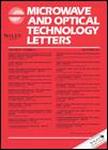版权所有:内蒙古大学图书馆 技术提供:维普资讯• 智图
内蒙古自治区呼和浩特市赛罕区大学西街235号 邮编: 010021

作者机构:Hangzhou Dianzi Univ Engn Res Ctr Smart Microsensors & Microsyst Hangzhou Peoples R China Beijing Inst Technol Sch Integrated Circuit & Elect Beijing Peoples R China Zhejiang Lab Hangzhou Peoples R China Hangzhou Dianzi Univ Engn Res Ctr Smart Microsensors & Microsyst Hangzhou 310018 Peoples R China
出 版 物:《MICROWAVE AND OPTICAL TECHNOLOGY LETTERS》 (微波和光学技术快报)
年 卷 期:2023年第65卷第8期
页 面:2323-2330页
核心收录:
学科分类:0808[工学-电气工程] 070207[理学-光学] 07[理学] 08[工学] 0803[工学-光学工程] 0702[理学-物理学]
基 金:National Key research and development program of China [2018YFB2201703] Hangzhou Innovation Institute, Beihang University [2020-Y5-A-021] National Natural Science Foundation of China [61971174, 62175056] Zhejiang Provincial Natural Science Foundation of China [LQ21F010002]
主 题:antenna beam scanning PIN diode reconfigurable reflectarray
摘 要:A wideband and electrically reconfigurable reflectarray (RRA) is presented for X-band application. The unit cell is composed of two heterogeneous resonators, that is, a split resonator ring and a metallic patch, and two positive-intrinsic-negative (PIN) diodes integrated between these two resonators. A bias circuit on the bottom layer is designed to achieve the switching of the two states via properly placing the PIN diodes on the resonators with minimal electric field. One-bit phase quantization is obtained by switching two different resonant mode via controlling the ON or OFF state of two PIN diodes. The simulated results show that the proposed unit cell can achieve one-bit phase quantization with 180 degrees +/- 20 degrees and reflection coefficients of -1 dB from 9.5 to 10.8 GHz, corresponding relative bandwidth of 12.81%. In addition, a fully functional 12 x 12 RRA fed by a linearly polarized horn is theoretically designed, simulated, and fabricated. The measured results show that the main beam can be steered from -50 degrees to +50 degrees at operating frequency, for example, 10.1 GHz with 1.5 dB gain loss within the scanning range and 20.34% aperture efficiency. In addition, the measured average gain is about 17.5 dBi and 3 dB gain bandwidth is about 15.68% from 9.4 to 11 GHz. In virtue of wide bandwidth, stable radiation gain, and good beam scanning capability, the proposed RRA is promising for future wireless communication and radar.